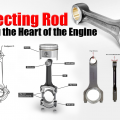Back in the V-10 days of Formula 1,
It wasn’t uncommon to see an engine rev to nearly 20,000 rpm a number you’d never see on a road car. It was only possible thanks to the engine’s extremely short stroke and wide bore.
Jason Fenske of Engineering Explained released a video breaking down;
How exactly changing an engine’s dimensions can develop more power,
Even if its overall displacement remains the same.
An engine’s bore is the diameter of each cylinder,
While the stroke is the distance within the cylinder the piston travels. An engine’s maximum power depends on how many rpm it can produce. The more rpm, the more power strokes, the more power it produces overall.
Also, read:
- Replacing a master cylinder and servo unit
- FIRING ORDER: ITS PURPOSE AND ORDER IN DIFFERENT NUMBERS OF CYLINDERS
- Caliper Piston Won’t Compress: Common Causes & Solutions
So it makes sense that the most powerful engines also rev the highest. Because a piston with a short-stroke doesn’t have to travel as far each cycle,
It can cover a greater distance in the same amount of time versus an engine with a longer stroke and smaller bore. That means more rpm. Similarly, a bigger bore means bigger valves,
Which means it can take in and push out more air in each cycle. And more air means more power.
It works in the opposite direction, too. Let’s say your aim is efficiency rather than power. The best engine to have, then, would be one with a small bore and a long stroke. Why? Well, it’s a bit more complicated than the power equation, but it involves surface area. The more surface area a cylinder has during its combustion,
The less energy is lost to heat, resulting in a more efficient cycle.
Also, read:
- How Variable Valve Timing Works, And How it Makes Your Engine Better
- SOHC Vs. DOHC – Which Engine Is Better?
These are just simple explanations, though. If you want to learn all there is to know about bore and stroke,
Check out Fenske’s video above.



3 Comments